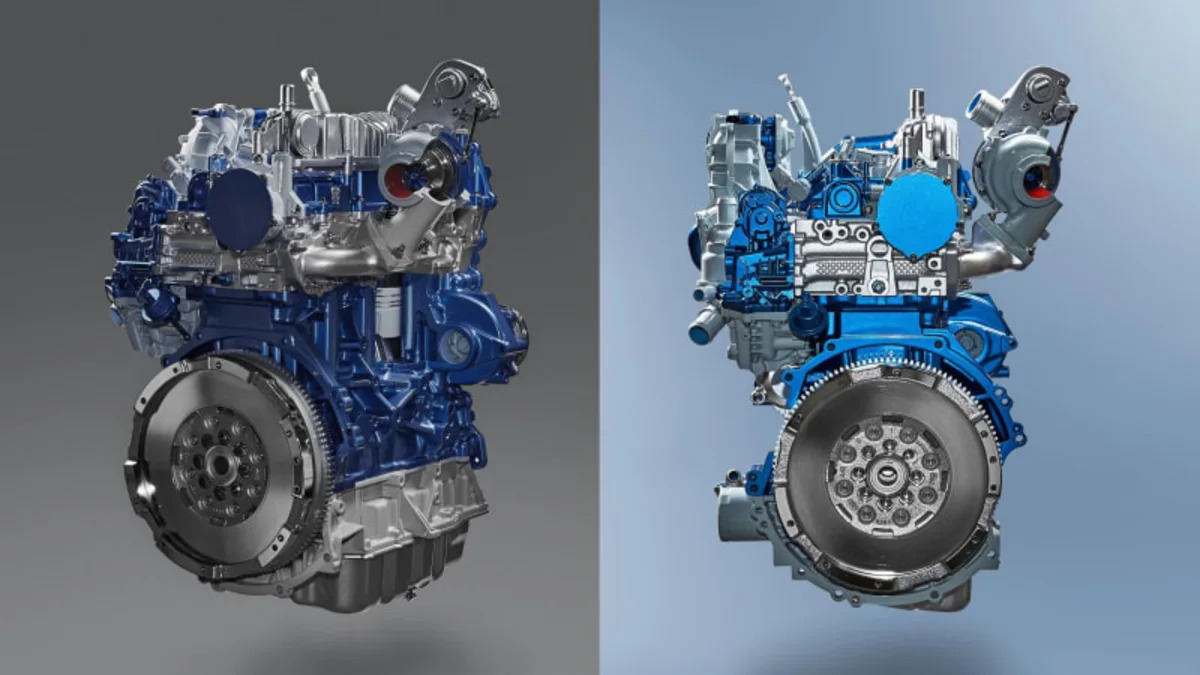It could not be born out of more turbulent times: Ford's new, two-liter EcoBlue diesel engine is being unveiled just as manufacturers around the world face embarrassing diesel emissions probes. But Ford says its new unit is clean and a clean-sheet design.
The 2.0-liter EcoBlue replaces the 2.2-liter Duratorq engine, which dates back to 2005 and powered vehicles as diverse as the Transit van, the Jaguar X-Type, and the Land Rover Defender. The new engine will first see use in commercial vehicles, such as the Transit van, and will later make it to passenger cars. There will also be a 1.5-liter EcoBlue four-cylinder for smaller vehicles, and it's likely that engine will also be fitted in the Transit Connect for Europe.
Ford says the engine is designed to reduce internal friction compared to its predecessor, with improvements including the use of an offset crankshaft and modular camshafts. Together with a belt-in-oil setup, this helps improve fuel efficiency by 13 percent. The new turbocharger apparently employs "rocket engine materials" for heat resistance; in this case it's a turbine wheel made from Inconel, an aerospace aluminum. The integrated inlet manifold uses a mirror-image porting design for more precise airflow into the cylinders, resulting in a more fine-tuned combustion process.
Compared to the outgoing 2.2-liter engine, the 2.0-liter EcoBlue's low-range torque at 1250 rpm has been improved by 20 percent, which should make city driving easier. The big deal, especially amid current black clouds over diesel emissions, is that Ford says the engine meets stringent September 2016-onwards Euro 6 emission standards. Those require a 55-percent reduction in NOx emissions compared to the earlier Euro 5 standards.
Initially, the EcoBlue will be available in three different tunes, ranging from 105 horsepower to 170 hp in commercial vehicles. There will be more-powerful versions available, at best producing 200 to 240 horsepower in passenger cars.
According to Ford, the engine meets its global commercial-vehicle durability standards, meaning the European-designed unit could well be shipped across the Atlantic for US van applications.
Related Video:

The 2.0-liter EcoBlue replaces the 2.2-liter Duratorq engine, which dates back to 2005 and powered vehicles as diverse as the Transit van, the Jaguar X-Type, and the Land Rover Defender. The new engine will first see use in commercial vehicles, such as the Transit van, and will later make it to passenger cars. There will also be a 1.5-liter EcoBlue four-cylinder for smaller vehicles, and it's likely that engine will also be fitted in the Transit Connect for Europe.
Ford says the engine is designed to reduce internal friction compared to its predecessor, with improvements including the use of an offset crankshaft and modular camshafts. Together with a belt-in-oil setup, this helps improve fuel efficiency by 13 percent. The new turbocharger apparently employs "rocket engine materials" for heat resistance; in this case it's a turbine wheel made from Inconel, an aerospace aluminum. The integrated inlet manifold uses a mirror-image porting design for more precise airflow into the cylinders, resulting in a more fine-tuned combustion process.
Compared to the outgoing 2.2-liter engine, the 2.0-liter EcoBlue's low-range torque at 1250 rpm has been improved by 20 percent, which should make city driving easier. The big deal, especially amid current black clouds over diesel emissions, is that Ford says the engine meets stringent September 2016-onwards Euro 6 emission standards. Those require a 55-percent reduction in NOx emissions compared to the earlier Euro 5 standards.
Initially, the EcoBlue will be available in three different tunes, ranging from 105 horsepower to 170 hp in commercial vehicles. There will be more-powerful versions available, at best producing 200 to 240 horsepower in passenger cars.
According to Ford, the engine meets its global commercial-vehicle durability standards, meaning the European-designed unit could well be shipped across the Atlantic for US van applications.
Related Video:



Sign in to post
Please sign in to leave a comment.
Continue